engine Peugeot 206 CC 2002.5 Owner's Guide
[x] Cancel search | Manufacturer: PEUGEOT, Model Year: 2002.5, Model line: 206 CC, Model: Peugeot 206 CC 2002.5Pages: 128, PDF Size: 1.73 MB
Page 111 of 128
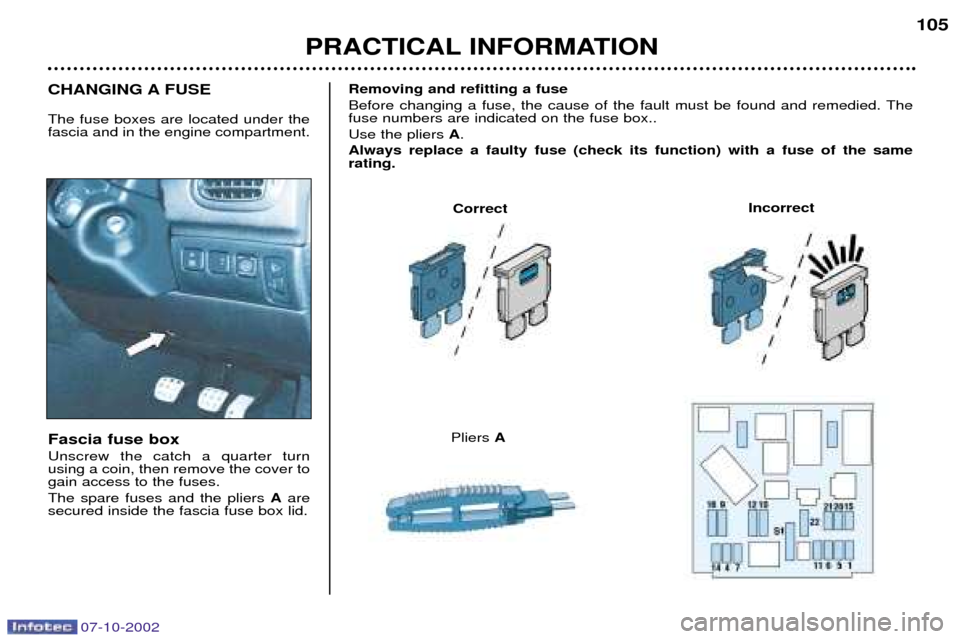
07-10-2002
PRACTICAL INFORMATION105
Fascia fuse box Unscrew the catch a quarter turn using a coin, then remove the cover togain access to the fuses. The spare fuses and the pliers
Aare
secured inside the fascia fuse box lid. Removing and refitting a fuse
Before changing a fuse, the cause of the fault must be found and remedied. The fuse numbers are indicated on the fuse box.. Use the pliers
A.
Always replace a faulty fuse (check its function) with a fuse of the same rating.
Correct Incorrect
CHANGING A FUSE The fuse boxes are located under the fascia and in the engine compartment.
Pliers
A
Page 112 of 128
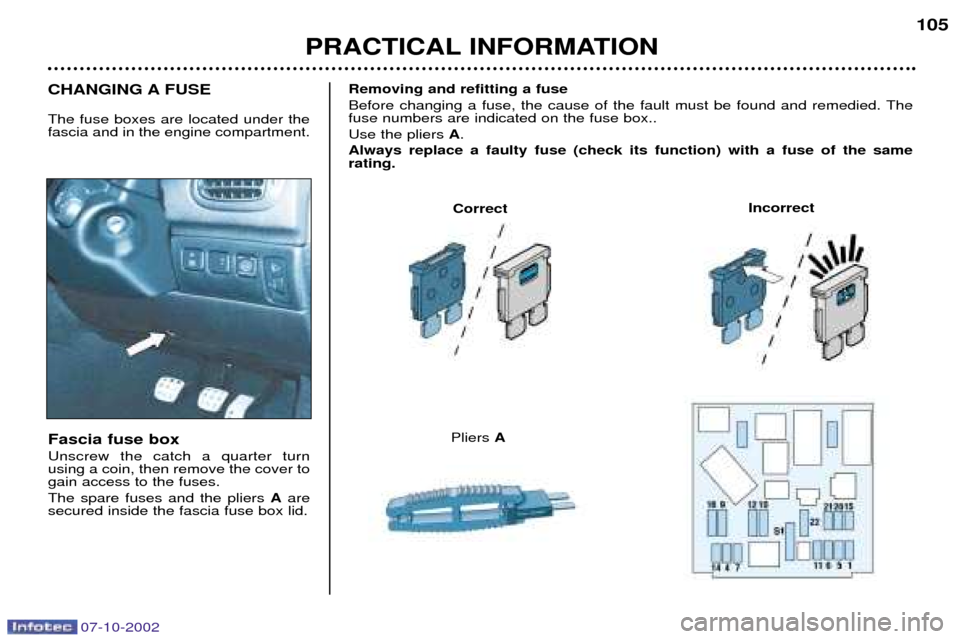
07-10-2002
PRACTICAL INFORMATION105
Fascia fuse box Unscrew the catch a quarter turn using a coin, then remove the cover togain access to the fuses. The spare fuses and the pliers
Aare
secured inside the fascia fuse box lid. Removing and refitting a fuse
Before changing a fuse, the cause of the fault must be found and remedied. The fuse numbers are indicated on the fuse box.. Use the pliers
A.
Always replace a faulty fuse (check its function) with a fuse of the same rating.
Correct Incorrect
CHANGING A FUSE The fuse boxes are located under the fascia and in the engine compartment.
Pliers
A
Page 113 of 128

07-10-2002
Fuse RatingFunctions
1 15A Alarm siren
4 20A Multifunction display - Navigation control unit - Boot lighting - Radio - Retractable roof control unit
5 15A Automatic gearbox diagnosis
6 10A Coolant level - Automatic gearbox - Radio - Steering wheel angle sensor (ESP)
7 15A Driving school accessories - Alarm - Rain sensor
9 30A Hydraulic pump
10 40A Exterior mirror demisting 11 15A Wiper
12 30A Front windows
14 10A Engine fuse box - Air bags - Steering wheel stalks
15 15A Instrument panel - Multifunction display - Navigation control unit - Air conditioning - Radio
16 30A Door locking / unlocking controls - Deadlocking controls
20 10A Right brake light
21 15A Left brake light - 3rd brake light
22 30A Front courtesy light - Glove box lighting - Cigarette lighter
S1 Shunt PARC shunt PRACTICAL INFORMATION
106
Page 114 of 128

07-10-2002
PRACTICAL INFORMATION107
Fuse no. Rating Functions
1* 20A Fan unit
2* 60A ABS/ESP
3* 30A ABS/ESP
4* 70A Built-in systems interface supply
5* 70 A Built-in systems interface supply
6* Ð Not used
7* 30 A Ignition switch supply
8* Ð Not used Engine compartment fuse box
To access the unit located in the engine compartment (next to the bat-
tery), unclip the cover. After changing the fuse, close the
cover very carefully.
Your vehicle's electrical circuit is designed to oper-ate with standard oroptional equipment.
Before installing additional electri-cal equipment or accessories,
consult a PEUGEOT dealer. Some electrical accessories, or the way in which they are fitted,may adversely affect the operationof your vehicle (the electronic con-trol circuits, the radio circuit andthe electrical charging circuit). PEUGEOT does not accept any responsibility for expensesincurred by repairs or for any faultsresulting from the installation ofadditional accessories which arenot supplied or recommended byPEUGEOT and which were notinstalled in accordance with themanufacturer's instructions, in par-ticular equipment with a consump-tion greater than 10 milliamps.
* The maxi fuses provide additional protection for the electrical systems. Any work on them must be carried out by a PEUGEOT dealer.
Page 115 of 128
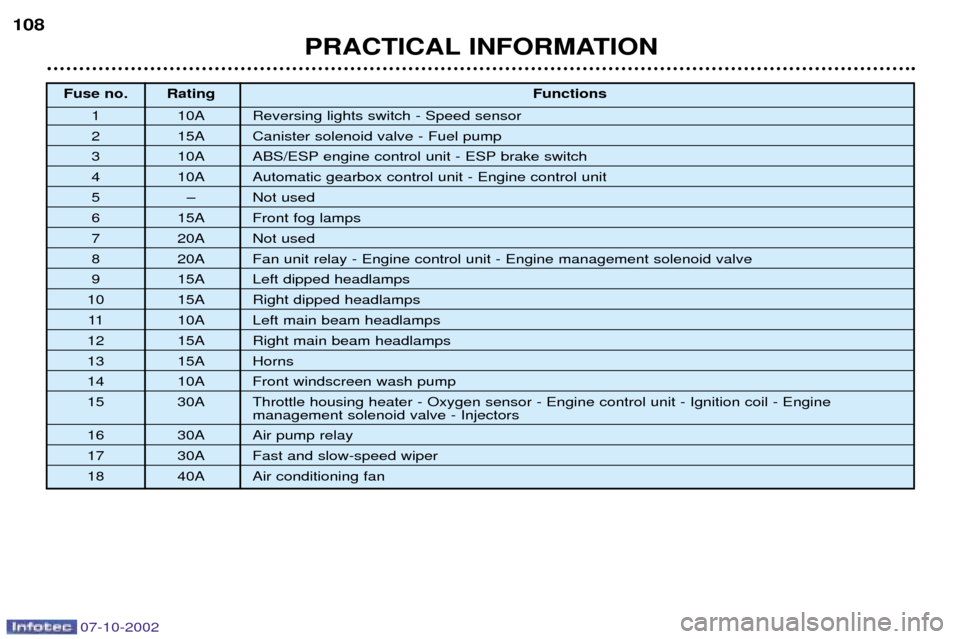
07-10-2002
PRACTICAL INFORMATION
108
Fuse no. Rating
Functions
1 10A Reversing lights switch - Speed sensor
2 15A Canister solenoid valve - Fuel pump
3 10A ABS/ESP engine control unit - ESP brake switch
4 10A Automatic gearbox control unit - Engine control unit
5 Ð Not used
6 15A Front fog lamps
7 20A Not used
8 20A Fan unit relay - Engine control unit - Engine management solenoid valve
9 15A Left dipped headlamps
10 15A Right dipped headlamps
11 10A Left main beam headlamps
12 15A Right main beam headlamps
13 15A Horns
14 10A Front windscreen wash pump
15 30A Throttle housing heater - Oxygen sensor - Engine control unit - Ignition coil - Engine
management solenoid valve - Injectors
16 30A Air pump relay
17 30A Fast and slow-speed wiper
18 40A Air conditioning fan
Page 116 of 128

07-10-2002
PRACTICAL INFORMATION109
BATTERY
To charge the battery using a battery charger:
Ð Disconnect the battery,
Ð Follow the instructions for use given by the battery charger manufacturer,
Ð Reconnect starting with the negative (Ð) terminal,
Ð Check that the terminals and connectors are clean. If they are covered with sul-
phate (white or greenish deposit), disconnect them and clean them.
To start the vehicle from another battery:
Ð Connect the red cable to the positive (+) terminals of the two batteries,
Ð Connect one end of the green or black cable to the negative (Ð) terminal of the slave battery,
Ð Connect the other end of the green or black cable to an earth point on the bro- ken down vehicle as far as possible from the battery,
Operate the starter, let the engine run.
Wait for the engine to return to idle, then disconnect the cables. ECONOMY MODE FUNCTION After the engine has stopped, with the key in the accessories position, cer-
tain functions (windscreen wiper, elec-tric windows, courtesy lights, audioequipment etc.) can only be used forthirty minutes, to prevent discharging
the battery.
Once the thirty minutes are over, the message
"Economy mode active"
appears on the multifunction displayand the active functions are put on
standby.
A flat battery will prevent the engine from starting.
Ð Never disconnect a terminal when the engine is running.
Ð Never charge a battery without first disconnecting the terminals.
Ð After every reconnection of the battery, switch on the ignition and
wait 1 minute before starting to allow the electronic systems to be ini- tialised. If slight difficulties are experienced after this, please contact
a PEUGEOT dealer.
It is advisable to disconnect the battery if the vehicle is not
to be used for a period of more than one month.
Page 119 of 128

07-10-2002
PRACTICAL INFORMATION
112
TOWING A TRAILER,
CARAVAN, BOAT etc.
Only use original PEUGEOT tow bars that have been tested andapproved from the design stage of
your vehicle. The tow bar must be
fitted by a PEUGEOT dealer. The tow bar must be fitted by a
PEUGEOT dealer.
Your vehicle is basically designed for transporting people and luggage but it
may also be used for towing a trailer. Driving with a trailer subjects the towing vehicle to more significant stress andits driver must be particularly careful. Air density decreases with altitude, thus
reducing engine performance. Above
1 000 metres, the maximum towing load
must be reduced by 10 % for every
1 000 metres of altitude. Driving advice Distribution of loads:
Distribute the
load in the trailer so that the heaviest items are as close as possible to the axleand the nose weight approaches themaximum permitted without exceeding it. Cooling: Towing a trailer on a slope
increases the temperature of the coolant. As the fan is electrically controlled, its cooling capacity is not dependent onthe engine speed.
On the contrary, use a high gear to lower the engine speed, and reduceyour speed. The maximum towing load on a long slope depends on the gradient and theoutside temperature. In all cases, pay attention to the coolant temperature. If the warning light comes on, stop the
vehicle and switch off the engine assoon as possible. Tyres:
Check the tyre pressures of the
towing vehicle and of the trailer,observing the recommended pres-sures. Braking: Towing increases the brak-
ing distance. Lights: Check the electrical signalling
on the trailer.Side wind: Take into acount the
increased sensitivity to side wind.
Page 125 of 128
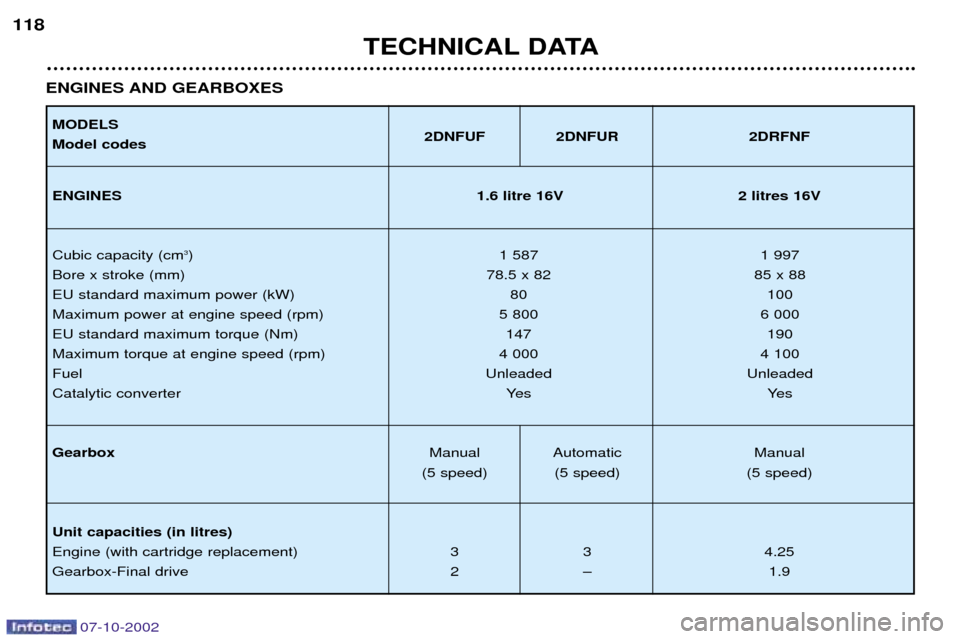
07-10-2002
TECHNICAL DATA
118
MODELS Model codes
2DNFUF 2DNFUR 2DRFNF
ENGINES 1.6 litre 16V 2 litres 16V
Cubic capacity (cm 3
) 1 587 1 997
Bore x stroke (mm) 78.5 x 82 85 x 88
EU standard maximum power (kW) 80 100
Maximum power at engine speed (rpm) 5 800 6 000
EU standard maximum torque (Nm) 147 190
Maximum torque at engine speed (rpm) 4 000 4 100Fuel Unleaded Unleaded
Catalytic converter Yes Yes
Gearbox Manual Automatic Manual
(5 speed) (5 speed) (5 speed)
Unit capacities (in litres)
Engine (with cartridge replacement) 3 3 4.25Gearbox-Final drive 2 Ð 1.9
ENGINES AND GEARBOXES
Page 126 of 128
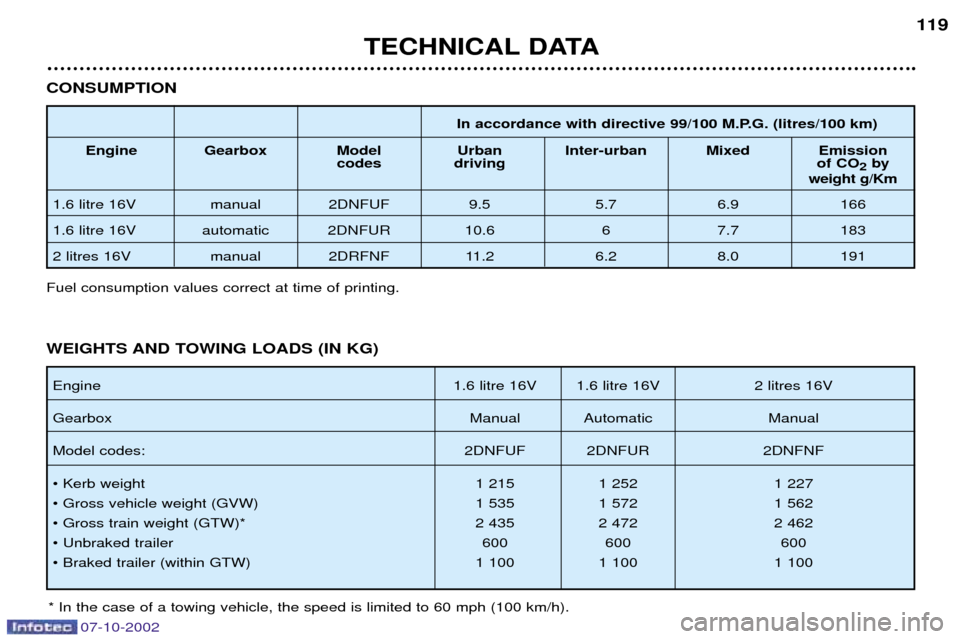
TECHNICAL DATA119
In accordance with directive 99/100 M.P.G. (litres/100 km)
Engine Gearbox Model Urban Inter-urban Mixed Emission codes driving of CO
2by
weight g/Km
1.6 litre 16V manual 2DNFUF 9.5 5.7 6.9 166
1.6 litre 16V automatic 2DNFUR 10.6 6 7.7 183
2 litres 16V manual 2DRFNF 11.2 6.2 8.0 191
CONSUMPTION
Fuel consumption values correct at time of printing.
Engine 1.6 litre 16V 1.6 litre 16V 2 litres 16V
Gearbox Manual Automatic Manual
Model codes: 2DNFUF 2DNFUR 2DNFNF
¥ Kerb weight 1 215 1 252 1 227
¥ Gross vehicle weight (GVW) 1 535 1 572 1 562
¥ Gross train weight (GTW)* 2 435 2 472 2 462¥ Unbraked trailer 600 600 600
¥ Braked trailer (within GTW) 1 100 1 100 1 100
WEIGHTS AND TOWING LOADS (IN KG)
* In the case of a towing vehicle, the speed is limited to 60 mph (100 km/h).
07-10-2002
Page 128 of 128
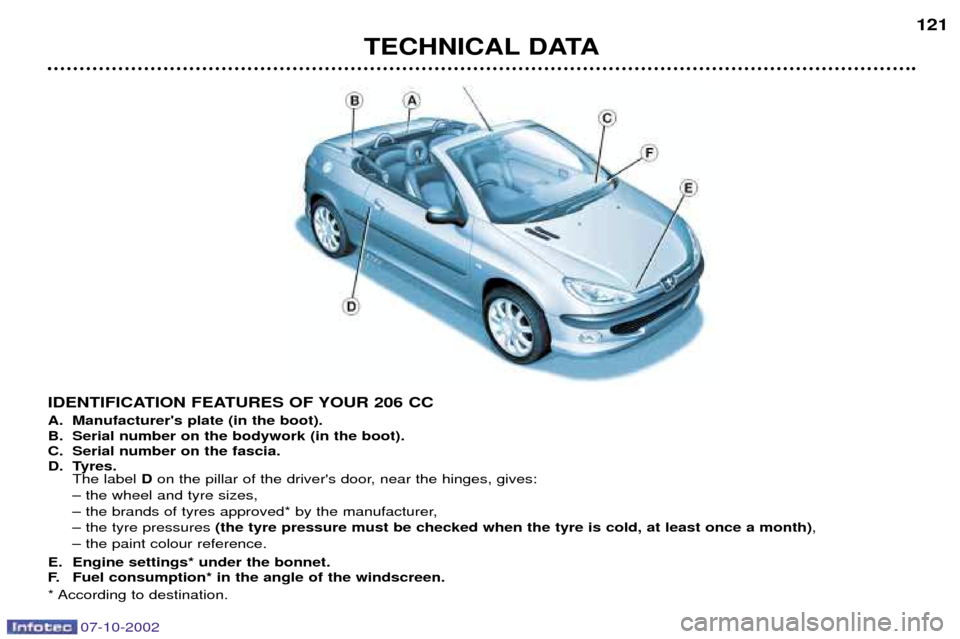
07-10-2002
TECHNICAL DATA121
IDENTIFICATION FEATURES OF YOUR 206 CC
A. Manufacturer's plate (in the boot).
B. Serial number on the bodywork (in the boot).
C. Serial number on the fascia.
D. Tyres.
The label Don the pillar of the driver's door, near the hinges, gives:
Ð the wheel and tyre sizes,
Ð the brands of tyres approved* by the manufacturer,Ð the tyre pressures (the tyre pressure must be checked when the tyre is cold, at least once a month) ,
Ð the paint colour reference.
E. Engine settings* under the bonnet.
F. Fuel consumption* in the angle of the windscreen.
* According to destination.